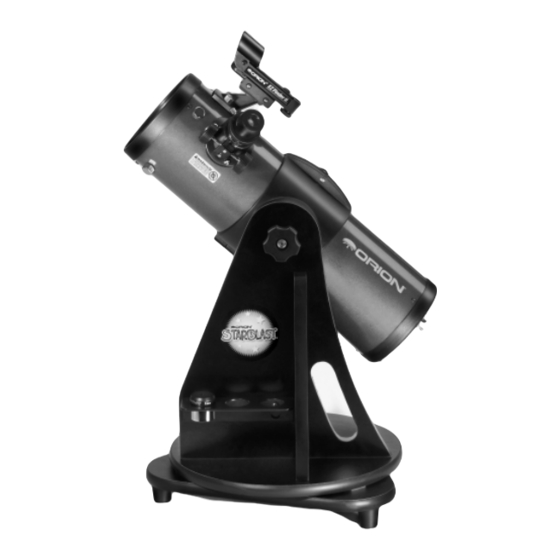
Orion StarBlast 4.5" Instruction Manual
Hide thumbs
Also See for StarBlast 4.5":
- Instruction manual (14 pages) ,
- Instruction manual (16 pages) ,
- Instruction manual (16 pages)
Subscribe to Our Youtube Channel
Summary of Contents for Orion StarBlast 4.5"
- Page 1 Library Telescope Program Sponsored by Central Arkansas Astronomical Society (CAAS) Orion StarBlast 4.5" Telescope INSTRUCTION MANUAL...
- Page 2 WARNING: Never look directly at the Sun through your telescope or its finder scope — even for an instant — as permanent eye damage could result. Do not point the telescope at the Sun, as parts will melt! Children should use this telescope only with adult supervision. INTRODUCTION The Central Arkansas Library System Library Telescope Project (LTP) is supported by the Central Arkansas Astronomical Society (CAAS), which provides training for library...
- Page 3 Telescope Parts 1) Eyepiece (Zoom 8 to 24 mm) 2) EZ Finder with AA battery box 3) Telescope tube 4) Focuser 5) Tube Clamp 6) Altitude Clamp 7) Mirror Assembly 8) Support 9) Handle 10) Eyepiece rack (removed)
- Page 4 Focuser Details 13) Focus wheels 14) Eyepiece securing screws (replaced with hex screws) EZ Finder Details...
-
Page 5: Transporting The Telescope
Transporting the Telescope The easiest way to carry the scope is to place your forearm under the telescope tube when it is in a level position, and lift, holding the upright support against your side. When in a car, simply place the scope on a seat and use a seatbelt to secure it. -
Page 6: Getting Started
Fog on the mirrors and eyepieces: One of the odd things that happens when star-gazing is that dew forms on pretty much everything (and everyone). The big mirror is tucked safely down at the bottom of the telescope, and so it does not get much dew on it. Eyepieces, however, often have dew form on them, making them useless until they warm up and dry out. - Page 7 This is a “Push-to” telescope. Once you find what you are looking for, you can either watch the object move through your “field of view” (what you see through the eye piece) and then reposition the telescope, or keep pushing the scope to hold the object in the center of the eyepiece. Objects appear to move across the field of view faster at higher magnifications.
- Page 8 Focusing the Telescope: Try out the telescope during the day when you can see what you’re doing. Remove the dust caps from the eyepiece and telescope tube. The “power” of a given telescope depends upon the eyepiece you use. This scope has a Zoom eyepiece.
- Page 9 If you find that it’s awkward to put your eye up to the eyepiece, you can rotate the telescope tube by loosening the knob on the tube clamp and moving the telescope tube until the focuser is in a convenient position. Be sure to tighten it again! You may find that the telescope tube is either too hard to move or does not stay in place.
- Page 10 the red dot. If not: Without moving the telescope, use the EZ Finder’s left/right (azimuth) and up/down (altitude) adjustment knobs to position the red dot on the object in the eyepiece. If the red dot is centered on the object in the eyepiece, you’re done! The finder scope has a battery pack attached to the telescope.
- Page 11 Objects to Observe: The Moon is one of the easiest and most interesting targets to view with your telescope. Lunar craters, “seas” (relatively flat large dark gray areas filled with ancient lava flows), and even mountain ranges can all be clearly seen from a distance of 238,000 miles away! With its ever- changing phases, you’ll get a new view of the Moon every night it’s up.
- Page 12 stars. (Look at the middle star in the handle of the Big Dipper, Mizar. It is really two stars very close together. Being able to see the two stars separate is called “Star Splitting”. The gorgeous two-color double star, Albireo, in Cygnus is a favorite. Defocusing a star slightly can help bring out its color.
- Page 13 Pay particular attention to objects with a “Messier Number”, like The Orion Nebula (M-42) and the Andromeda Galaxy (M- 31). First published in 1774, Charles Messier made this list to help observers identify objects that might be mistaken for comets.
- Page 14 for it. For example: To find the Pinwheel Galaxy, M 101, look for the last two stars of the Big Dippers handle. They make the base of a triangle that has the M 101 at the top. You can also try a low-power (24 mm) scanning of the Milky Way: just cruise through the “star clouds”...
- Page 15 transparency is. If you can see all the stars, you are doing pretty well. Be sure to wait until your eyes adapt to the dark. One more time, and with Feeling! WARNING: Never look directly at the Sun through your telescope or its finder scope —...
- Page 16 "The best thing that we're put here for's to see; The strongest thing that's given us to see with's a telescope. Someone in every town seems to me owes it to the town to keep one. In Littleton it may as well be me." Brad McLaughlin, quoted by Robert Frost in “The Star Splitter”...

















Need help?
Do you have a question about the StarBlast 4.5" and is the answer not in the manual?
Questions and answers